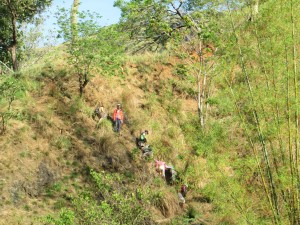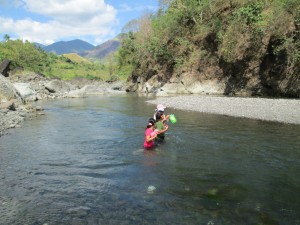By Maricar Calubiran
San Agustin is 18 kilometers away from the town proper of Valderrama, and is subdivided by rivers and mountains.
In this village live the Indigenous Peoples’ (IP) Group of Iraynon-Bukidnon, one of the two ethnographic groupings – the Ati and Bukidnon, scattered throughout the Western Visayas. These IP groups live in less accessible mountainous areas in the provinces of Aklan, Antique, Iloilo, Guimaras, and Negros Occidental.
To reach the IP village from the town proper, one has to ride a habal-habal (motorcycle for hire) going to the nearby village of Lublub, passing the Cangaranan River.
My journey to the ancestral land of the Iraynon-Bukidnons opened my eyes to the reality that somewhere in the middle of the mountains is a marginalized community which has been long waiting for the services of the national government.
We are fortunate that when we went to the village, the water is shallow and the habal-habal drivers can have the tires of their single motorcycle washed in the river. According to the locals, when the water is high, they usually take a bamboo raft to cross the Cangaranan River.

The 20-minute motorcycle ride from the town proper to Lublub is a combination of crossing rivers and traversing steep mountains. Local drivers are admirably skillful the passengers don’t break their bones in going up and down that mountain.
From Lublub, there are two options to reach Brgy San Agustin, either to pass by the Cadian River or to trek the mountains for about two hours. Of course, the trekking is longer for the guests than for the locals. Indeed, non-residents who want to reach the IP village need guts, determination, and patience to reach the place.
Trekking the treacherous trail of Mt. Lag-it, for me, courts accident if not death. One has to climb and crawl while saying silent prayers to God and calling all the angels for assistance. It is God’s blessing no one from our team is harmed despite the several trips and slides.
To keep ourselves feeling positive in that very challenging trek, we delighted ourselves by enjoying the blooming sunflowers and by listening to the humming of birds.
It helps avoiding rivers and rocks covered by moss to conquer acrophobia. But that trek is also an opportunity to see the village in a larger perspective – women with various agricultural produce in their heads trot the difficult trails gracefully, like they’ve been crossing that river and mountains since the day they were born.
On the shallow part of the river, there are men, wearing goggles and armed with spears, catching dalopingan, a freshwater fish, either for their own consumption or to be sold.
It is funny how our guides did not want us to walk under the scorching heat of the sun but forgot their trekking skills are very way ahead of ours. Nevertheless, we thanked him for the experience.
It helps to have a mountaineer Kalahi worker, Chester Regondon, who sees to it that my two little feet can reach the ground and always remind me to hold tightly and to not look down.
It also pays to bring a knife while trekking. Little holes are dug in the steep portion of the mountains like an improvised ladder for us to reach the ground. We have an instant rock-climbing experience since we have to step our feet in the holes.

In spite of the difficulties, a member of the Municipal Coordinating Team managed to crack a joke, saying we will have a “priceless reward” when we reach the barangay proper. And that reward is a bowl of stewed dalopingan and a plate of freshwater shrimps called orang.
Talking and listening to the IP stories and beliefs comes the realization that there are other people who are out there struggling to be a part of a bigger community. They display the true resilience of the Filipino spirit, by surviving each day, regardless of how.
Kalahi-CIDSS entry to the town of Valderrama is not a magic pill that would immediately solve the problems of the IPs that were already problems decades or generations ago. The solution requires the participation of the people, barangay local government unit, municipal local government unit, and provincial local government unit.
The IP’s inclusion in the Kalahi-CIDSS is one of scaling up initiatives of the program with the hope that the development will help them get the respect, help, and attention they so deserved./dswd6
